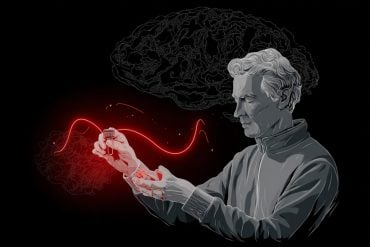Summary: A neural circuit that decodes the start, duration, and sudden change of speed of locomotion has been identified.
Source: Karolinska Institute
Researchers at Karolinska have uncovered how brain circuits encode the start, duration and sudden change of speed of locomotion.
The study is published in Neuron.
Locomotion—”moving around” in the form of walking, running or swimming—is a universal behavior that allows us to interact with the world around us.
An accurate control of the start and duration of a locomotor episode, combined with the ability to execute prompt changes in vigor and speed, are key features for the flexibility of locomotion. For example, we can suddenly change the speed of our locomotion from slow walking to running to adjust to our surroundings.
“Using the zebrafish as a model system, our previous work has revealed that the neurons in the spinal cord responsible for the execution of locomotion are assembled in circuits that comprise three modules, which act as gearshift mechanisms to increase the speed,” says Abdel El Manira, Professor at the Department of Neuroscience, and corresponding author of the article.

“An outstanding question that re-mained unsolved is how the upstream circuits, residing in the brain-stem, encode and convey the start, duration and change in locomotor speed to these executive circuits in the spinal cord.”
Important findings
By exploiting the relative accessibility of adult zebrafish, combined with a broad range of techniques, the researchers can now reveal two brain circuits that encode the start, duration and sudden change in locomotor speed.
The brain circuits represent the initial step in the sequence of commands coding for the onset, duration, speed and vigor of locomotion. The two command streams revealed here, with their direct access to the spinal circuits, allow the animal to navigate through their environment by grading the speed and strength of their locomotor movements, while at the same time controlling directionality. These mechanisms in adult zebrafish can be extrapolated to mammalian model systems.
Mapping connectivity
The next step will be to map the connectivity between these brain circuits and those in the spinal cord driving locomotion.
Hopefully, the circuit revealed in the study can guide designing novel therapeutic strategies aimed at restoring motor function after traumatic spinal cord injury.
About this neuroscience research news
Author: Press Office
Source: Karolinska Institute
Contact: Press Office – Karolinska Institute
Image: The image is credited to Eva Berg
Original Research: Open access.
“Brainstem circuits encoding start, speed, and duration of swimming in adult zebrafish” by Eva Berg et al. Neuron
Abstract
Brainstem circuits encoding start, speed, and duration of swimming in adult zebrafish
Highlights
- MLF nucleus comprises vGlut2+ and vGlut1+ neuronal subpopulations
- vGlut2+ neurons encode the onset and duration of swimming
- vGlut1+ neurons encode sudden increase in swimming speed and strength
- vGlut2+ neurons control slow swim, whereas vGlut1+ neurons drive fast escape-swim
Summary
The flexibility of locomotor movements requires an accurate control of their start, duration, and speed. How brainstem circuits encode and convey these locomotor parameters remains unclear.
Here, we have combined in vivo calcium imaging, electrophysiology, anatomy, and behavior in adult zebrafish to address these questions.
We reveal that the detailed parameters of locomotor movements are encoded by two molecularly, topographically, and functionally segregated glutamatergic neuron subpopulations within the nucleus of the medial longitudinal fasciculus.
The start, duration, and changes of locomotion speed are encoded by vGlut2+ neurons, whereas vGlut1+ neurons encode sudden changes to high speed/high amplitude movements. Ablation of vGlut2+ neurons compromised slow-explorative swimming, whereas vGlut1+ neuron ablation impaired fast swimming.
Our results provide mechanistic insights into how separate brainstem subpopulations implement flexible locomotor commands.
These two brainstem command subpopulations are suitably organized to integrate environmental cues and hence generate flexible swimming movements to match the animal’s behavioral needs.






